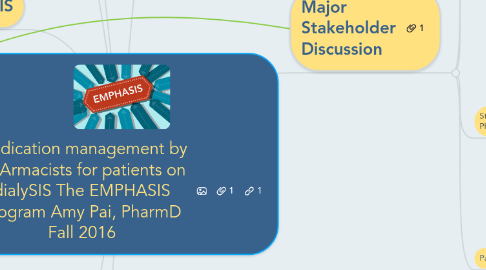
1. References
2. Key Questions for Implementation "See the opportunity in the problem" (Fonseca, p.25)
2.1. What are pivotal targets within the UM ACO model that I need to target?
2.1.1. Reduction in emergency department visits
2.1.2. Reduction in hospitalizations
2.1.3. Reductions in lengths of stay
2.1.4. Deprescribing
2.2. How can I ensure that the infrastructure can be maintained with student pharmacists? (Woodard et al, 2016)
2.3. What are the key elements of the program that need to be in place to make it reproducible?
2.3.1. Development of evidence based protocols will be key to reproducing at other dialysis units especially if they do not have a pharmacist trained in dialysis. This has been effective in other models (Aquiar et al. 2016)
2.4. How can I efficiently track outcomes prospectively?
2.4.1. UM electronic health record
2.4.2. REDCap data managements system
2.4.3. Work with Fresenius Medical Care to create data interface between dialysis treatment data and UM care data
2.5. "Leaders who can deal with complexity are in short supply" (Weiss & LeGrand, 2011)
3. Outcomes for EMPHASIS
3.1. Short-term within 30 days
3.1.1. medication list concordance
3.1.2. Identification of medication-related problems
3.2. Intermediate within 6 months
3.2.1. Patient health literacy
3.2.2. Proportion of patients achieving serum phosphorus concentration ≤5.5 mg/dL (Mayne et al, 2012)
3.2.3. Dialysis treatment adherence
3.3. Long-term within 3 years
3.3.1. Patient satisfaction with MMS service
3.3.2. Mortality rate
3.3.3. Hospitalization rate
3.3.4. Hospital length of stay
3.3.5. Rate of hospital readmission within 30 days of discharge
3.3.6. Total health care system costs
3.4. Who: Pharmacist collects all medication and lab data, University of Michigan collects all outcomes data
3.5. "Know when best practices may not apply." (Weiss & LeGrand, 2011)
3.6. "Actions must be co-coordinated to succeed in the solution" (Fonseca, 2002)
4. Anticipated Barriers and Resistance
4.1. Nurses may feel that they were competently doing medication reconciliation and services are not needed
4.1.1. Solution: Discuss the formal process of medication reconciliation takes time and this service is making their time more efficient
4.2. Team may not want to address medications "owned" by other prescribers
4.2.1. Solution: Frame each medication-related problem presented with the desired clinical outcome and financial impact if applicable (Pai, 2013)
4.3. Dialysis provider (Fresenius Medical Care) does not have familiarity with clinical pharmacy services
4.3.1. Solution: Propose a scale up pilot so dialysis unit staff become familiar with pharmacy services
4.3.2. Solution: Create a prospectus for FMC leadership
4.4. Need to help resistors envision solution as complex not complicated (Weiss & LeGrand, p.21).
4.5. "Leaders see networked systemness" (Porter-O'Grady & Malloch, p.9)
5. Implementation Plan and Timeline
5.1. Student Onboarding and Scale-up plan
6. System Theory: Impact and Scalability
6.1. Dialysis Patients are at High Risk for Medication-related Problems (USRDS, 2015)
6.2. Total cost of care continues to rise among ESRD patients, with an estimated $31 billion in total Medicare expenditures in 2013, and over $11 billion due to hospitalizations.
6.3. The EMPHASIS program will be a scalable program utilizing student pharmacists from the University of Michigan (UM) College of Pharmacy to perform systematic medication management for patients at the affiliated UM dialysis center which is jointly run with Fresenius Medical Care
6.3.1. Overall Expected Impact of the EMPHASIS program: Better health care: Better health: Lower cost:
6.3.1.1. Societal Impact and Scalability
6.3.1.1.1. Health-related quality of life and patient satisfaction are poor among
6.3.1.1.2. Patients with end-stage renal disease comprise 0.7% of Medicare users but consume 7% of the Medicare budget-impacting resources for other patients
7. Major Stakeholder Discussion
7.1. University of Michigan (UM) Director of Quality for Faculty Group Practice and Director Pioneer Affordable Care Organization Project
7.1.1. Role: Key stakeholder for potential scale up to all 9 ACO partners affiliated with UM
7.1.2. "Organizations that live in stability are not adaptable" (Porter-O"Grady & Malloch, 2010)
7.2. Director of Innovative Ambulatory Care Pharmacy Practices
7.2.1. Role: Political spokesperson for new pilot program to members of the ACO around the state of Michigan, extensive experience developing and assessing metrics to demonstrate reduction in total costs of care (Choe, 2005)
7.2.1.1. DiSC personality assessment interpretation based on several meetings: iD. I will need to ensure we both stay focused since we both have a tendency to look big picture and move on to other projects before completion
7.3. Student Pharmacists at UM College of Pharmacy
7.3.1. Role: Student pharmacists will be the key mechanism by which care is delivered. This is where I can be proactive in selecting complementing personalities and learners. I successfully implemented a program at Albany College of Pharmacy in NY and look forward to engaging UM students.
7.3.1.1. DiSC personalities that will benefit project:
7.3.1.1.1. Proactively selecting students that fit into these personalities will help them cultivate their own innovative leadership styles (Kelley, 2005)
7.4. Patients
7.4.1. Patient Satisfaction
7.4.2. Perceived Value Added
7.4.3. Engagement
